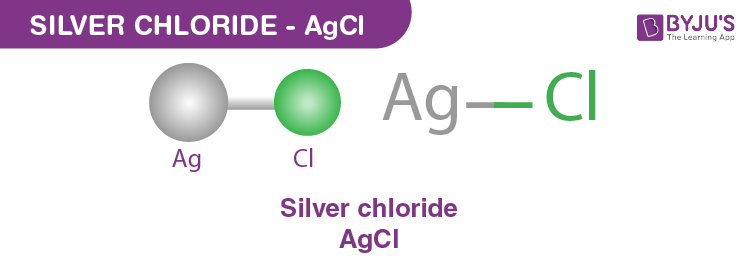What is Silver chloride?
Silver chloride is a white crystalline chemical compound with the formula AgCl. Silver chloride in the test tube quickly turns purplish, especially in a sunny laboratory because the silver chloride is split up into silver and chlorine. Silver chloride is prepared when sodium chloride is added to silver nitrate solution a white precipitate of silver chloride occurs. Silver chloride is an example of a well-known salt stain used to impart an amber colour to the glass.
Other name – chloro silver
| AgCl | Silver chloride |
| Density | 5.56 g/cm³ |
| Molecular weight/ Molar mass | 143.32 g/mol |
| Boiling point | 1,547 °C |
| Melting point | 455 °C |
| Chemical formula | AgCl |
Table of Contents
- Silver chloride Structure
- Physical Properties of Silver chloride – AgCl
- Chemical Properties of Silver chloride – AgCl
- Uses of Silver chloride – AgCl
- Frequently Asked Questions
Silver chloride Structure

Physical Properties of Silver chloride – AgCl
| Odour | No odour |
| Appearance | White powder |
| Complexity | 2 |
| Vapour pressure | 670/1Pa |
| Covalently-bonded Unit | 1 |
| Solubility | Insoluble in water |
Chemical Properties of Silver chloride – AgCl
- Silver chloride undergos decomposition reaction in the presence of sunlight to form silver and chlorine. The chemical reaction is as follows.
2AgCl → 2Ag + Cl2
- Silver chloride reacts with bases like ammonia forming a complex compound called Silver diammonium ion and chloride ion.
AgCl + 2NH3 → [Ag(NH3)2]+ + Cl–
Uses of Silver chloride – AgCl
- The most effective form of water-activated battery uses magnesium as the anode and silver chloride as the positive electrode.
- Used in electroplating and polishing mirrors and in making alloys.
- Used as an antidote that reacts with the poison to produce a harmless chemical compound.
- Used in medicines and silver salts are used in photographic films.

Comments